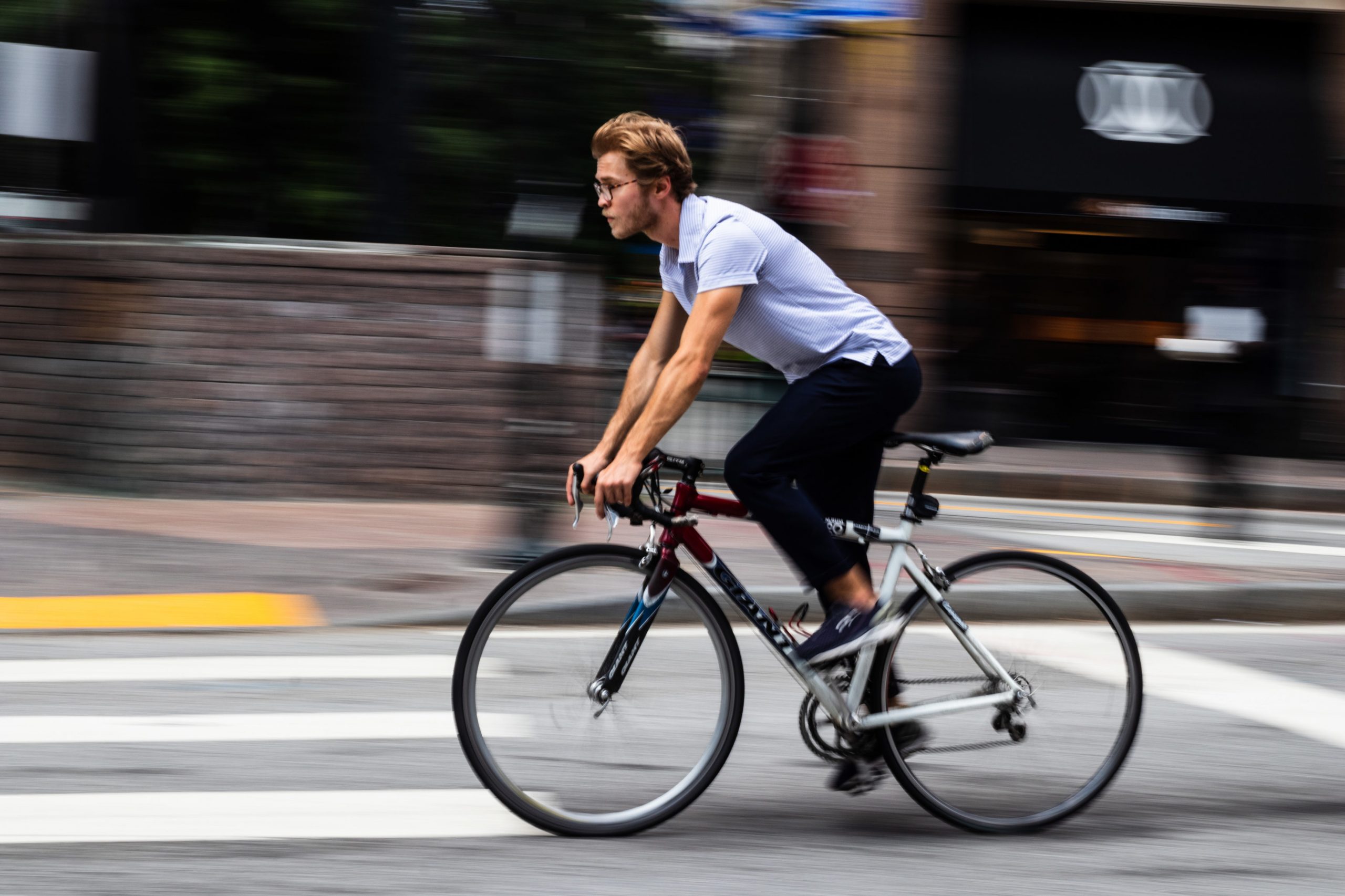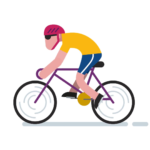
Many students begin cycling in college as an easy way to get around. A new city or a new school can be hard enough, but cycling is a new hobby, skill, sport and mode of transportation all at once. God, what a lot of work. Let’s get started.
BIKING IN ATLANTA:
Russell Luke is a graduate student at Georgia State. He said he rides 35 miles a week, on average. He rides a steel touring bike with flat bars, disk brakes, lugged tires and roll-top pannier bags. He enjoys his commute and said the roads around Georgia State are some of the safest he’s experienced in Atlanta.
“It’s really conducive to biking,” Luke said. “There’s a lot of spaces to put your bikes and everything and people have their heads on a swivel.”
He used to live and bike in Buffalo, New York but said Downtown has a lot to offer to cyclists.
“[In Buffalo,] there’s a tenth of the people,” Luke said. “You don’t have to be quite as alert. Honestly, in Atlanta there’s a lot more bike paths … some ways better and some ways worse.”
NEW CYCLISTS:
Patrick Goral is a mechanic at Loose Nuts Cycles bike shop in Grant Park. He started working on bikes as soon as he was riding them. He admits his early experiments might have been misguided, requiring frequent trips to repair shops to fix his poor repairs.
He can laugh about it now, but those early lessons can be hard-won for many cyclists. He’s got a few road tips for the beginner cyclist.
“I see a lot of new cyclists riding on the sidewalks,” Goral said. “You’re legally allowed to take the full lane… The biggest thing you can do is make every movement you’re doing as obvious as possible. Any quick movements you do, cars can’t react fast enough.”
CHOOSING YOUR ROUTE:
Choosing your route can have a huge impact on your safety. Knowing the road conditions comes with time, but there are ways to do your research before you hop into the saddle.
“The shortest route isn’t always the best,” Goral said. “I would usually stay off Moreland and certain parts of Memorial.”
The Atlanta Bicycle Coalition has compiled a set of resources for the best bike routes around the city. They also sponsor the app, Cycle Atlanta, available for both Android and iPhone. The app tracks your bike rides and sends the data to the City of Atlanta. The data collected helps transportation officials repair roads and make plans for road improvements.
ROAD CONDITIONS:
Ice and rain are dangerous, but downtown riders know the especially embarrassing pain of a run-in with the Atlanta Streetcar tracks. If you’re not careful, there is a guarantee you will get caught. The Atlanta Downtown Improvement District (ADID) published a video on general streetcar safety, which included a message to cyclists on the best way to avoid the tracks.
GET THE RIGHT EQUIPMENT:
Goral said too many people buy bikes but don’t ride them because they’re not comfortable. When you know the kind of riding you’re doing, making a few changes can make it so much better. Goral always starts from the ground up.
TIRES:
“The first thing is better tires,” Goral said. “It’s always smart to have a front and rear light.”
But what makes a nice set of tires? Changes to tire weight and geometry make for different ride qualities. Choosing a lighter tire means more agile riding, with tighter cornering and easier starting after stopping. Wider tires means more cushion over Atlanta’s many bumps and provide better contact in the rain. For preventing flats, you want thick rubber and a high PSI. It’s hard to have it all sometimes, so take the time to think about what style of riding you prefer.
CONTACT POINTS:
“Another huge one is any contact point, anywhere your body is touching the bike,” Goral said. “Grips, bar tape, saddles and pedals. You can make a really cheap bike feel much nicer just by having something you’re comfortable on.”
HANDLEBARS:
The choices can be overwhelming but there’s a pretty easy flow to it. Flat bars and riser bars encourage a more upright and relaxed riding posture. These are favored by many commuters because the added height extends your field of view.
If you find hills challenging, bullhorns are a must. The forward posture moves weight off the back wheel, making pedaling that much easier. Not that we recommend it as a lifestyle, but for the speed demons who live to barrel down hills, drop bars give you that aggressive track bike posture you’ve always dreamed about.
BUILD A COMMUNITY:
The choices seem overwhelming at first but it never hurt anyone to ask for help. Once you’ve made a few friends who bike, it’s like you’re all learning together.
Group rides are a great way to meet riders like you, and Atlanta has more weekly rides than days in the week. One of Goral’s favorite weekly group rides is Mash to Brash, which meets at Loose Nuts Cycles every Wednesday at 6:15 p.m. and finishes at BRASH Coffee for a ride of four miles.
Goral says he likes the ride for the laid back and learning attitude the riders share. The ride is “no-drop”, meaning they don’t leave behind those who don’t keep pace. What’s more, they always follow road rules, which is admittedly somewhat of a rarity among Atlanta’s group rides.
“It’s a cool ride because it’s super inclusive, it’s pretty much people come out on any bike, for any kind of rider,” Goral said. “It’ a good way to meet a lot of people.”
BIKE PARKING:
When you’re cutting around campus, bike parking is underneath Library Plaza which connects Kell Hall, Sparks Hall and Student Center East and West. There are well-maintained bike lanes on John Portman Blvd., Peachtree Center Ave. and Edgewood Ave. MARTA installed bike repair kiosks at all stations in 2016. Have a flat? You can do most simple fixes at the bike repair stands at either the Georgia State or Five Points stations.
FIND A BIKE RACK:
If you are unsure where to park, ADID has an online resource for every easily accessible bike rack downtown. For extra safety, don’t just lock up through the wheel. Those come off easy. You can always improvise a bike rack from a gate, fence or street sign. Even a tree will work. Make sure you fasten the lock through the wheel and frame, securing all parts to the bike rack. You don’t always need to be that careful, but we’ve all seen those forgotten bike frames by the University Commons missing wheels. Don’t be that guy, and for any parking over an hour, it’s better safe than sorry.
LOOK FOR BIKE PATHS:
The PATH Foundation has built over 260 miles of bike paths through the city since 1991. The paths merge with roads and diverge through city parks. One ambitious project, the Silver Comet Trail, goes as far as the Alabama state line. Most paths run through Downtown and Midtown, but the most recent T-SPLOST paid for a path connecting the Bankhead MARTA station to the Grove Park neighborhood through the Proctor Creek Greenway.

